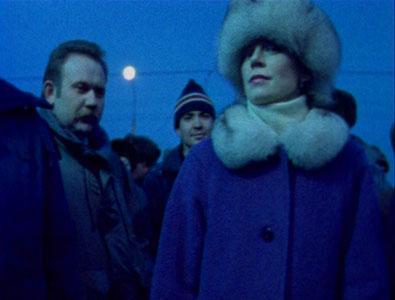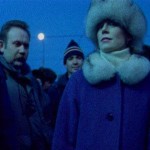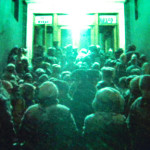By JAMES NADEAU
"Here we have images which only receive actions on one facet or in certain parts and only execute reactions by and in other parts. These are, so to speak, 'quartered' images."
-Gilles Deleuze
Akerman is thought to be one of the more sublime filmmakers working today. Her work surpasses documentary, experimental and narrative boundaries creating viewing experiences that are moving, often transcendental and quite powerful. But how does the work translate from a singular filmic experience to that of an installation? Many filmmakers have made the transition from one to the other, Derek Jarman, Peter Greenaway and Pierre Huyghe to name a few, with varying degrees of success. The List Center at MIT has brought her first survey show to Cambridge from the Blaffer Gallery, The Art Museum at the University of Houston and it is representative of the ways in which this type of shift can both succeed and fail.
Time, memory and space play a large role in the work of Akerman. Her films speak to the way we remember events and places. They actively move across and through spaces loaded with meaning, either personally or socio-politically (sometimes both simultaneously). And this is the crux of the problem with the show. The cinematic experience of the theatre allows one the time (there's that word again) to sit and think, contemplate, as the images play across the screen. When watching D'est (From the East, 1993) in a theatre the images move before you, both across the screen and through time as you experience it linearly. The film is a tour across Eastern Europe as the Soviet Union disintegrates. It is shot as a pan across the landscape; the audio is purely ambient sound with no dialogue. It is a film that literally crosses space, from East Germany to Russia, and time, from summer to winter, with a slow moving fluidity that is mesmerizing to behold, not to mention experience (it is very much like Aleksandr Sokurov's Russkiy kovcheg [Russian Ark} from 2002 -- clearly he was inspired by Akerman).
In 1995 Akerman transformed D'est into D'est: Au bord de la fiction (From the East: Bordering on Fiction) into her first installation piece. Here the film is excerpted into eight triptychs displayed on twenty-four monitors, all placed at eye level (approx four feet or so) in the gallery. Each excerpt is a four-minute looped sequence. The placement in the gallery is quite remarkable, monitors arranged in groups of three, staggered into the gallery, allow one to interact with each piece intimately or as a whole. It is a treat for the eye but I had to distance my knowledge of the original film in order to not feel disappointed. D'est had lost its meaning and its power here. While visually stunning (and I should say that the installation of the show is exceptional), the disbursement of the film into mini-bits really defused the complexities that were integral to the original; beautiful but to what effect? This installation methodology is also used for De l'autre côté (From the Other Side), 2002 with the very same effect. A powerful exploration of illegal immigrants and the Mexican/American border is distilled into visual sound bites. Thankfully, this film also contains moments of interviews that help to guide one through the dispersed narrative or at least serve to impart information.
Les Femmes d'Anvers en Novembre (Women in Antwerp in November), 2007 is a new work commissioned specifically for this exhibition. Here, once again, Akerman has adapted an original film of hers (a film projection that was part of Belgian artist Jan Fabre's multi-media performance piece I'm a Mistake) to create a "two-channel video Installation concerning the social, psychological, and emotional connotations of smoking." The videos consist of women smoking, alone or in groups. This was the weakest piece in the show. Certainly it was visually interesting, well shot, beautifully lit, and well composed but it resonated as a one-note piece. Now, I am not a smoker. I smoke occasionally but in general cigarettes play very little role in my life. The group I was with included several smokers who really enjoyed this piece, so perhaps that is the key to engaging with this installation. So, smokers out there -- this is your art. Me, not so much.
The powerhouse piece in the show has to be Sud (South) from 1999. While teaching film at Harvard, Akerman became interested in making a film about America. Inspired by the writings of William Faulkner and James Baldwin, she decided to focus on the South. What started as an investigation into southern life and racial integration became a film about space and memory centering on the murder of James Byrd, Jr. in 1998. Akerman films the entire three-mile stretch of road that Byrd was dragged along in Jasper, Texas. Shot out of the back of the car, the camera captures every foot in excruciating slowness. This is intercut with interviews with people who live on the road, each describing the detritus left behind by Byrd's killers. It is truly one of the more moving testaments to power, race, and memory that I have experienced. This is the strength of Akerman as an artist. Her work makes you think deeply about space, time, identity and memory as it pertains to cultural and social identities. The work is intense and passionate. It takes an intellectual distance to read the work as distinct. When you can get to that point, then the show is a wonder to behold.
- Chantal Akerman, D’est, documentary, 35mm, color, 107 min, 1993.
- Chantal Akerman, D’est, documentary, 35mm, color, 107 min, 1993.
"Chantal Akerman: Moving Through Time and Space" is on view May 2 - July 6, 2008 at The List Visual Arts Center.
All images are courtesy of the artist and The List Visual Arts Center.






